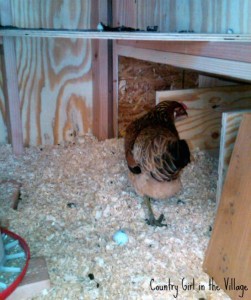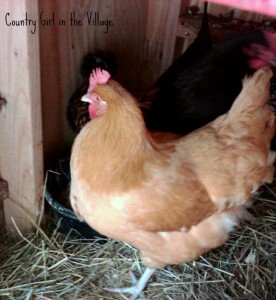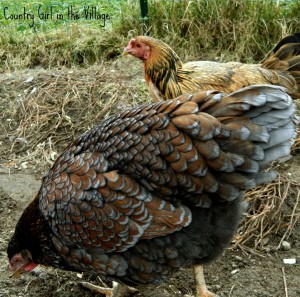Snow has been forecast and it is time to begin our winter rituals in regards to our Chicken Coop. We have a small backyard flock. Their coop is 5 foot by 5 foot with a height of 5 feet. This houses 4 birds comfortably. They have a high roosting pole and also nest boxes that are attached on one side and do not take up precious floor space. This size coop helps in a Michigan winter by keeping things compact enough not to have drafty areas but is not too large that we may have need for any type of heat lamp. In fact, we do not heat our coop at all. We have found that bird selection, choosing hardy breeds, and the Deep Litter Method of bedding has worked well for our flock. This method helps to give layers from the cold of the coop floor as well as insulate as the litter grows in size.

The Deep Litter Method is a process of layering bedding on top of bedding essentially creating a compost-like setting inside your coop. One that is not as “hot” as your outdoor compost pile, but does break down biologically. Important components of this litter method is the litter itself, manure and moisture. Two of these you want and one you don’t. Your litter choice will effect the moisture inside your coop. Moisture is the component we do not want. It is important to keep your coop dry and well ventilated. We use pine shavings as well as some hay in the bedding. I say some, as I like to sprinkle some hay on the coop floor, but not enough to form a layer of bedding. Hay is not as absorbent as the pine shavings. The pine shavings work to keep out moisture and the hay gives the Ladies something to scratch about. This scratching inside the coop mimics how we turn a compost pile and aids in aerating the litter.

Depending on your number of birds, you will need to add more bedding as it breaks down in the coop. We start with 4-6 inches of bedding and can grow to a foot by Spring. You are working against moisture from droppings as chickens do not urinate. However, nature and biology are working with you. There is a natural process at work in your deep litter. Bacteria and other microbes are always present. These microbes will begin to break down the droppings and litter, much like the natural occurrence of decomposition of organic material on a forest floor.

Your litter, if done right, will become a living little ecosystem. Doesn’t that sound tasty? Well, not to me and I am sure other chicken keepers but it does sound tasty to your birds. The microbes and decomposers in your litter can provide some added nutrition for your flock. As your birds are stirring up the litter and scratching about they are adding oxygen, an essential part of decomposition, as well as finding bugs to eat. This all sounds messy though. In a well ventilated coop that is well tended too and kept dry, the smell is minimal. If ammonia smell becomes strong, air out your coop. Open the doors and windows and add more bedding.
In the Spring, you can spread the love of deep litter method to your compost pile, garden and flower beds. Well broken down litter is an excellent source of nitrogen and other nutrients. Fresh litter will have too high of a nitrogen level to add to your garden, but the months old broken down litter will have turned into a nutrient rich soil aid.














6 Comments
Would this work in their run if it could get wet from rain? Their coop is above part of their run, so it’s not very deep to put in deep litter.
I use sand and pine shavings on the floor of the coop. The sand takes care of the moisture, and the sand helps keep the coop a little warmer at night. Each week, I go in and clean up a little, and add more pine shaving to the floor.
We do a version of this but I was told by a person at a garden center that pine shavings can leach moisture out of the garden because they are so absorbent. Anybody know anything about that?
Folks always talk about keeping the humidity and moisture out of the coop. What is the ideal range for humidity in a close coop? I have a cheapie thermometer in my coop and my coop runs about 85% humidity. That seem high” to me but I don’t know how to get it down? I have 5/6 week old babies with momma in my coop (insulated on the top).I really hesitate to open windows when it is sub zero outside!!
Donna at the Small House Homestead
http://smallhouseunderabigskyhomestead.wordpress.com
I use this method and it works great. I also sprinkled a handful or two of bird seed in the coop every morning. Gives the girls something to hunt for and helps turn the bedding as well. Great article!
Thanks for your advice. We also In close their yards with heavy plastic. Top to bottom. Have you ever used Koop Clean? Good luck with your fine feathered family!